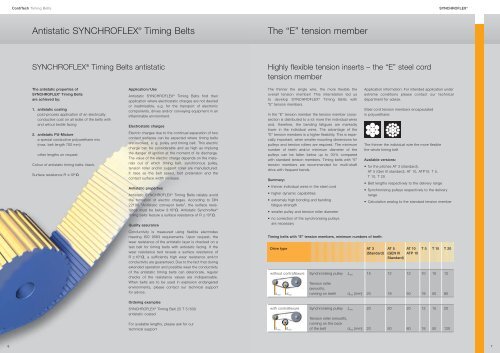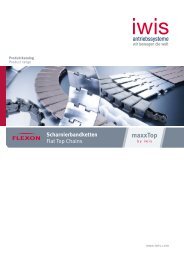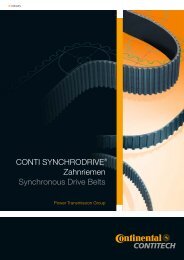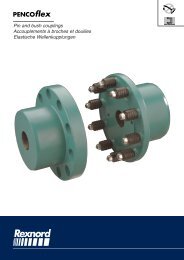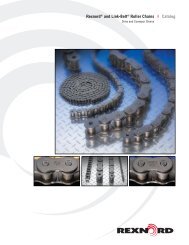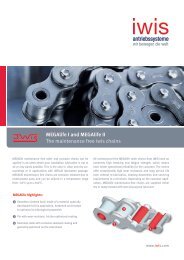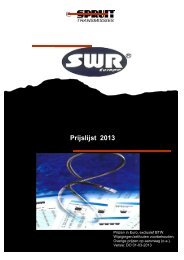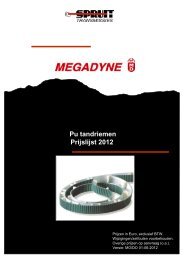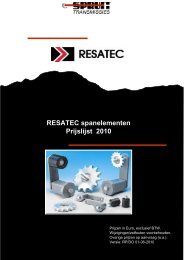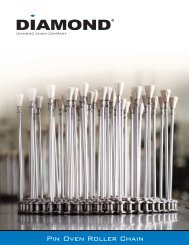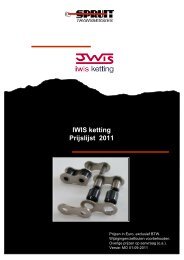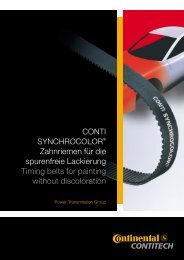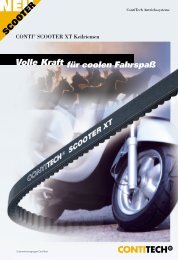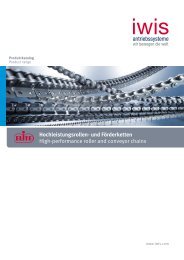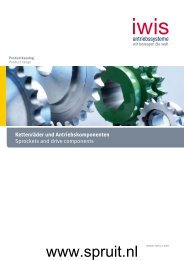Product Range SYNCHROFLEX® Timing Belts - Power ...
Product Range SYNCHROFLEX® Timing Belts - Power ...
Product Range SYNCHROFLEX® Timing Belts - Power ...
You also want an ePaper? Increase the reach of your titles
YUMPU automatically turns print PDFs into web optimized ePapers that Google loves.
ContiTech <strong>Timing</strong> <strong>Belts</strong><br />
SYNCHROFLEX ®<br />
Antistatic SYNCHROFLEX ®<br />
<strong>Timing</strong> <strong>Belts</strong><br />
The “E” tension member<br />
SYNCHROFLEX ® <strong>Timing</strong> <strong>Belts</strong> antistatic<br />
Highly flexible tension inserts – the “E” steel cord<br />
tension member<br />
The antistatic properties of<br />
SYNCHROFLEX ® <strong>Timing</strong> <strong>Belts</strong><br />
are achieved by:<br />
1. antistatic coating<br />
post-process application of an electrically<br />
conductive coat on all sides of the belts with<br />
and witout textile facing<br />
2. antistatic PU-Mixture<br />
a special conductive polyurethane mix<br />
(max. belt length 700 mm)<br />
other lengths on request<br />
Colour of antistatic timing belts: black.<br />
Surface resistance R 10 6 <br />
Application / Use<br />
Antistatic SYNCHROFLEX ® <strong>Timing</strong> <strong>Belts</strong> find their<br />
application where electrostatic charges are not desired<br />
or inadmissible, e.g. for the transport of electronic<br />
components, drives and/or conveying equipment in an<br />
inflammable environment.<br />
Electrostatic charges<br />
Electric charges due to the continual separation of two<br />
contact surfaces can be expected where timing belts<br />
are involved, e. g. pulley and timing belt. This electric<br />
charge can be considerable and as high as implying<br />
the danger of ignition at the moment of its discharge.<br />
The value of the electric charge depends on the materials<br />
out of which timing belt, synchronous pulley,<br />
tension roller and/or support roller are manufactured.<br />
It rises as the belt speed, belt pretension and the<br />
contact surface width increase.<br />
Antistatic properties<br />
Antistatic SYNCHROFLEX ® <strong>Timing</strong> <strong>Belts</strong> reliably avoid<br />
the formation of electric charges. According to DIN<br />
22104 “Antistatic conveyor belts”, the surface resistance<br />
must be below 3·10 8 . Antistatic Synchroflex ®<br />
timing belts feature a surface resistance of R 10 6 .<br />
The thinner the single wire, the more flexible the<br />
overall tension member! This interrelation led us<br />
to develop SYNCHROFLEX ® <strong>Timing</strong> <strong>Belts</strong> with<br />
“E” tension members.<br />
In the “E” tension member the tension member crosssection<br />
is distributed to a lot more thin individual wires<br />
and, therefore, the bending fatigues are markedly<br />
lower in the individual wires. The advantage of the<br />
“E” tension members is a higher flexibility. This is especially<br />
important, when smaller mounting dimensions for<br />
pulleys and tension rollers are required. The minimum<br />
number of teeth and/or minimum diameter of the<br />
pulleys can be fallen below up to 30% compared<br />
with standard tension members. <strong>Timing</strong> belts with “E”<br />
tension members are recommended for multi-shaft<br />
drive with frequent bends.<br />
Summary:<br />
• thinner individual wires in the steel cord<br />
• higher dynamic capabilities<br />
• extremely high bonding and bending<br />
fatigue strength<br />
• smaller pulley and tension roller diameter<br />
• no correction of the synchronising pulleys<br />
are necessary<br />
Application information: For intended application under<br />
extreme conditions please contact our technical<br />
department for advise.<br />
Steel cord tension members encapsulated<br />
in polyurethane:<br />
The thinner the individual wire the more flexible<br />
the whole timing belt<br />
Available versions:<br />
• for the pitches AT 3 (standard),<br />
AT 5 (Gen III standard), AT 10, ATP10, T 5,<br />
T 10, T 20<br />
• Belt lengths respectively to the delivery range<br />
• Synchronising pulleys respectively to the delivery<br />
range<br />
• Calculation analog to the standard tension member<br />
Quality assurance<br />
Conductivity is measured using flexible electrodes<br />
meeting ISO 9563 requirements. Upon request, the<br />
wear resistance of the antistatic layer is checked on a<br />
test belt for timing belts with antistatic facing. If the<br />
wear resistance test reveals a surface resistance of<br />
R 10 6 , a sufficiently high wear resistance and/or<br />
conductivity are guaranteed. Due to the fact that during<br />
extended operation and possible wear the conductivity<br />
of the antistatic timing belts can deteriorate, regular<br />
checks of the resistance values are indispensable.<br />
When belts are to be used in explosion endangered<br />
environments, please contact our technical support<br />
for advice.<br />
<strong>Timing</strong> belts with “E” tension members, minimum numbers of teeth:<br />
Drive type AT 3 AT 5 AT 10 T 5 T 10 T 20<br />
(Standard) (GEN III ATP 10<br />
Standard)<br />
without contraflexure Synchronising pulley z min 15 12 12 10 10 12<br />
z min<br />
d min<br />
Tension roller<br />
(smooth),<br />
running on teeth d min [mm] 20 18 50 18 50 80<br />
Ordering examples<br />
SYNCHROFLEX ® <strong>Timing</strong> Belt 25 T 5/630<br />
antistatic coated<br />
For available lengths, please ask for our<br />
technical support<br />
with contraflexure Synchronising pulley z min 20 20 20 12 15 20<br />
z min<br />
d min<br />
Tension roller (smooth),<br />
running on the back<br />
of the belt d min [mm] 20 50 80 18 50 120<br />
6<br />
7


